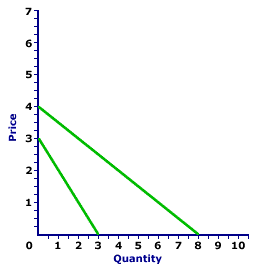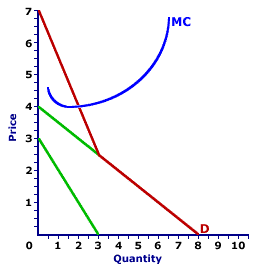Nonrival consumption and the inability to exclude nonpayers from consumption mean that public goods cannot be efficiently provided through market exchanges. However, the efficient production of public goods follows the same rules as the efficient production of private goods -- the value of the good produced must be equal to the opportunity cost of foregone production.For private goods this criterion is satisfied when the market price, the price that each and every buyer is willing to pay, is equal to the marginal (opportunity) cost of production.
For public goods, the criterion is slightly different. It is satisfied when the total value generated, the sum of the price each consumer is willing to pay, is equal to the marginal (opportunity) cost of production.
Public Good Demand
| The Set Up | 
|
The best place to begin this analysis of public goods efficiency is with the demand for public goods. Because public goods are nonrival in consumption, everyone can benefit at the same time. As such, the demand for a public good is found by summing the price that each person is willing to pay for a given quantity. In contrast, the demand for private goods is found by summing the quantity that each person is willing to buy at a given price. Public good demand is the vertical summation of individual demand curves and private good demand is the horizontal summation of individual demand curves.The exhibit to the right illustrates a representative public good demand curve in which the public, for ease of exposition, contains only two people. The public good in question is the Shady Valley Municipal Park. The two people are the cantankerous Roland Nottingham and generally mundane Duncan Thurly. Roland's demand for the good is represented by the top demand curve. Duncan's demand for the good is represented by the lower demand curve. Roland benefits more from the Shady Valley Municipal Park than does Duncan.
The overall demand curve for this public good is the vertical summation of the two individual curves, which can be identified by clicking the [Derive Demand] button. Note that for a given quantity, say 2 park benches per acre, the total "market" demand is obtained by summing the price Duncan is willing to pay ($1) with the price that Roland is willing to pay ($3).
The Marginal Cost of Production
Demand, of course, provides only half of the information needed for this efficiency analysis. The other half is provided by supply, or more specifically, the costs of production. This is true for private goods and also for public goods. Although nonrival consumption dictates that public goods are efficiently provided if the price to the public is zero ONCE PRODUCED, the efficient production of public goods requires a balance between demand and the cost of production.The marginal cost of producing public goods is governed by the same basic principles as for private goods. An increase in quantity inevitably results in diminishing marginal returns and increasing marginal cost. As such, the cost side of public goods production can be represented by a standard positively-sloped marginal cost curve. A click of the [Add Cost] button reveals the marginal cost curve for the production of the Shady Valley Municipal Park. As the size of the park increases, the marginal cost of production also increases.
The only notable difference between the marginal cost of producing public goods versus private goods is illustrated by this marginal cost curve. The marginal cost curve for public goods production lies entirely above both individual demand curves. The positioning of this marginal cost curve illustrates that the cost of producing public goods generally exceeds the willingness to pay of any single individual. That is, no single person benefits enough from a public good to cover the entire cost of production.
However, the marginal cost curve DOES NOT lie entirely above the total demand curve, D. In fact, it intersects this demand curve. If not, then no level of production would be efficient and any analysis would be unneeded.
Efficient Production
| Efficient Production |  |
Fortunately there is an intersection and an analysis of the efficient production of park benches can be informative. The question is: How many park benches should the Shady Valley government produce? Efficiency dictates that the value of the good produced equal the value of goods not produced, which is the opportunity cost. This is achieved at the intersection of the public good demand curve and the marginal cost curve. Click the [Efficiency] button to highlight this point.In this example, efficiency is achieved if the Shady Valley Municipal Park has 2 park benches per acre. The total value provided by this efficiency level of production is $2 per bench.
Willingness to Pay
Returning to this exhibit, there is one additional bit of information that can be obtained. An important conclusion is that efficiency is achieved when the marginal cost of production is equal to the SUM of the prices that ALL individuals are willing to pay. A click of the [Prices] button illustrates the price that Duncan and Roland are each willing to pay for the production of these park benches.Duncan (the lower green demand curve) is willing to pay only $1 per bench to have 2 benches per acre in the Shady Valley Municipal Park. Roland (the upper green demand curve and park bench lover) is willing to pay $3 per bench.
In terms of simple equations, public good efficiency is achieved with:
| Marginal Cost | = | Roland's Price | + | Duncan's Price |
In contrast, the efficient production of a private good is achieved when the price that EACH individual is willing to pay is equal to one another and equal to marginal cost of production.| Marginal Cost | = | Roland's Price | = | Duncan's Price |
Production versus Provision
Before leaving the efficiency production of public goods, an important point deserves a little emphasis. The act of producing public goods is different from the act of providing the public with access to public goods.The efficient production of public goods requires equality between the value received and the marginal cost of production, that is, the intersection of the demand curve and the marginal cost curve, as illustrated in this exhibit.
However, ONCE PRODUCED, efficiency entails that public goods be provided to society at ZERO PRICE. Because public goods are nonrival in consumption, the marginal cost of provision is ZERO. But, if individual users are NOT charged for access to public goods, the production of these public goods MUST be financed through general tax revenue, taxes that are NOT related in any way to the consumption or use of the public goods.
In other words, efficiency dictates that Shady Valley use general tax revenue (presumably sales or income taxes) to pay for the production of park benches. But once in place, any and all Shady Valley citizens can use the benches free of charge, a zero price.
PUBLIC GOODS: EFFICIENCY, AmosWEB Encyclonomic WEB*pedia, http://www.AmosWEB.com, AmosWEB LLC, 2000-2025. [Accessed: July 18, 2025].


